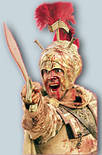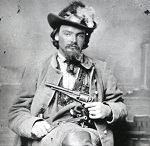
| Users Online Now: 2,076 (Who's On?) | Visitors Today: 1,280,489 | |
| Pageviews Today: 1,749,819 | Threads Today: 443 | Posts Today: 7,376 |
| 01:57 PM | ||
The Battle of Mine Creek and how Nobody messes with Kansas | |
| Anonymous Coward (OP) User ID: 75607292 07/19/2018 12:37 AM Report Abusive Post Report Copyright Violation | |
| Brown Chicken Brown Cow User ID: 70474957 07/19/2018 01:02 AM  Report Abusive Post Report Copyright Violation | |
| Brown Chicken Brown Cow User ID: 70474957 07/19/2018 01:04 AM  Report Abusive Post Report Copyright Violation | |
| Copperhead User ID: 76774121 07/19/2018 01:26 AM  Report Abusive Post Report Copyright Violation | |
| Anonymous Coward User ID: 73573470 07/19/2018 01:47 AM Report Abusive Post Report Copyright Violation | The Battle of Mine Creek, was a battle that occurred on October 25, 1864, in Kansas as part of Price's Raid during the American Civil War. In the second largest cavalry engagement of the war, two divisions of Major General Sterling Price's Army of Missouri were routed by two Federal brigades under the command of Colonels Frederick Benteen and John Finis Philips. Quoting: Anonymous Coward 75607292 Although outnumbered by more than two-to-one, the Union cavalry immediately commenced an attack. Col. Philips initially hesitated in the face of the overwhelming Confederate superiority in numbers, but he was overruled by Benteen (who would later ride to fame at the Battle of the Little Bighorn), who charged full-tilt into the Confederate center while Philips hit Price's left flank. Faced with this sudden assault, Fagan and Marmaduke ordered their men to remain mounted (rather than dismount, which had been their usual practice), turning the ensuing combat into one of the largest mounted cavalry engagements of the Civil War. Disaster nearly overtook the Federals, as Benteen's 10th Missouri Regiment inexplicably stopped their charge about halfway between their original position and the Confederate lines, refusing to start again until Major Abial R. Pierce of the 4th Iowa Cavalry galloped ahead of his regiment toward the Southern lines, followed in turn by his own regiment and then the rest of Benteen's brigade. Hitting the Confederates "like a thunderbolt", Union troopers forced the Confederate line to disintegrate like a row of bricks. Mass confusion reigned on the battlefield, as many of Price's men had donned captured Union uniforms, making it harder to distinguish between them and real Union soldiers. General Marmaduke was captured by an Iowa trooper named James Dunlavy, as he went to rally what he thought was a group of his own men (but who turned out to belong to Benteen's command). General Cabell similarly became a prisoner, as would nearly 1,000 of Price's army by the time the battle had ended. Confederate casualties were 1,200, including those wounded during the retreat. Union casualties were 100. Benteen and Philips continued their pursuit of Price's diminishing force, joining combat with it again at the Battle of Marmiton River later that same afternoon. The Army of Missouri would continue its withdrawal until reaching relative safety in Arkansas, though with only about one half of its original numbers. The great Missouri Raid had been a complete fiasco for Price, and the overall Union victory had precisely the opposite effect from what the Confederates had hoped, helping in Abraham Lincoln's successful campaign for reelection and contributing to the overall Union victory in the war. Kansas is now the save haven of the US. 65% of all nuclear payload is in the state in missile silos. The nation will protect Kansas at all costs rather than the White House. The Majority of the nation’s Medal of Honor winners come from Kansas. Kansas is the most conservative state of the union and we don’t take shit from nobody. BOW Before Kansas!! web.archive.org/web/20100708160723/ [link to webs.wichita.edu] The Battle of Mine Creek "The Battle of Mine Creek" was really a collection of skirmishes and maneuvers that took place during one day as Price retreated south from Marais des Cygnes. The evening of October 24, Price decided to camp his army along a ford in the Marais des Cygnes River near Trading Post. It was a rainy day and conditions were miserable. Not long afterward, the first of several waves of Union forces advanced onto the camp. Price collected his troops and continued southward, directing the advance guard of the retreat riding not on horseback, but in a carriage. Marmaduke's division lead the advance southward while that of Fagan served as a rear guard. In between, a massive wagon train struggled down the Old Military Road. Southern forces left so fast that advancing Union troops came across campfires with meat still cooking on the spits. Although the previous day had been rainy, the morning of October 25, 1864 started foggy but then became clear and sunny, a perfect fall day in Kansas. As dawn broke, Union forces under Pleasonton's Army of the Border took the mounds overlooking the Marais des Cygnes. Using cavalry as a pursuit force, Pleasonton sent out two brigades to overtake Price. The First Brigade, under the command of Colonel John Philips consisted of three regiments of Missouri State Militia and totaled 1,500 men. The Second Brigade under Lt. Colonel Frederick Benteen included regiments from Iowa, Missouri and two companies from the 7th Indiana. Benteen's brigade had about 1,100 men, making a total of 2,600 Union forces following Price. About 12 miles south of Marais des Cygnes, the road to Fort Scott crossed Mine Creek using a series of fords in the river. Price and the advance units crossed with little trouble. The wagon train, however, took more time. As the wagons slowly made it across of several fords in the creek, Price set up two defensive units. General William Cabell's division was south of the creek. Those of Fagan and Marmaduke were on the northern side, Fagan to the west and Marmaduke to the east. By 11:00 in the morning Price himself was about six miles south of Mine Creek. Meanwhile, Union forces finally caught up with the wagon train still trying to cross. Coming over the slight ridge, the two Union brigades, Philips' from the northwest and Benteen's from the northeast, encountered the Confederate forces struggling to get away. Philips hesitated, not sure that the men of his and Benteen's command were enough to take on the nearly 7,000 troops defending the wagon train. The more aggressive Benteen, however, saw this as a prime opportunity to trap Price's forces. Unwilling to wait for his senior officer to make the command decision, Benteen goaded his troops with bravado and swearing into launching the attack. Philip's men quickly followed suit and within moments, a line of Union cavalry charged down the slight slope to Mine Creek. Then, for reasons still not clear, the advance halted halfway down the slope, much to Benteen's dismay. It took a short while before units of the 10th Missouri and 4th Iowa continued the charge. Marmaduke and Fagan knew they were trapped and scrambled for a way to salvage the situation. Abandoning cavalry fighting protocol, which ordinarily would have had the mounted soldiers dismount to fight with guns on the ground, they ordered their troops to stay mounted and fight the best they could on horseback. Spread along several miles, the Southern cavalry and artillery was formidable but not in any condition to resist an attack. As Union mounted troops crashed through the Confederate line one of the largest cavalry battles of the Civil War took place, a heated engagement that lasted only about 20 or 30 minutes. The orderly lines dissolved into hand-to-hand combat. Although units from a number of states were involved, much of the fighting was Missourian versus Missourian. Adding to the confusion was the fact that many of Price's troops had scavenged Union uniforms during the raid, making Federal and Confederate nearly indistinguishable. Riding up to regroup what he thought were his own men, Marmaduke quickly found himself prisoner of 20-year old trooper from Iowa named James Dunlavy. Fagan tried to hold out longer but also found the Union advance too strong to resist. One of his brigade leaders, Cabell succumbed to the same confusion over uniforms as had Marmaduke. Cabell became the prisoner of another Iowan, Sergeant Calvary D. Young. When Price found out about the engagement, he quickly mounted his horse and returned to the battle. When he arrived, he realized it was too late to save the situation. Price decided to cut his losses. He had lost an estimated 300-400 men and had 500-1,000 captured, including two of his generals. With so many Missourians in Price's army, the number who deserted back to Missouri will never be known, especially since many would have worn Union uniforms. The Federals, by contrast, had less than 150 killed or wounded. In the aftermath locals of Linn County turned houses and other structures into hospitals for the wounded. Price regrouped his troops and continued southward along the road. He decided not to take Fort Scott, crossing back into Missouri just north of town. During the next several days Price retreated along the Kansas-Missouri border with Union forces close behind. Price faced a final defeat at Newtonia, Missouri on October 26. Even so, Price was able limp back to the safety of Arkansas in early November. Although often described as a Union victory, the battle at Mine Creek defied neat classification as a clear "win" or "loss" for either side. Union forces failed to completely stop or capture Price at Mine Creek, allowing him to escape back south. At Mine Creek, however, Price lost a significant percentage of his wagon train, a large number of his men, and several of his officers. Unable to defend his position, Price was forced to continue his retreat, his grand Missouri campaign a failure. Benteen got lucky. But he was also a traitor to the South and his own family. A drunk. And a fuckup that disobeyed orders and bears some of the responsibility for the loss of "Woman-Killer" Custer's command. And there were few Kansans there. |
